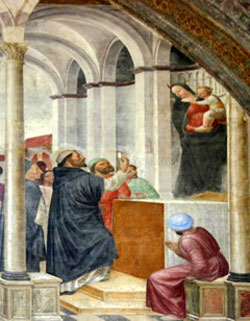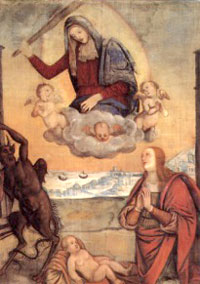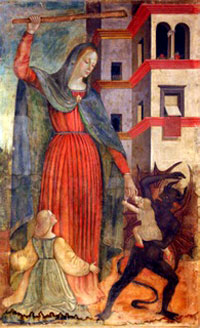This post on “Curious Appellatives of the Virgin Mary” is my translation and condensed version of a fascinating visual / textual essay published by Patrizia Fontana Roca on her website, www.cartantica.it.
Among the numberless appellatives of the Virgin Mary, records of Her infinite powers, some are indeed “curious.” Their “curiosity,” Patrizia underscores, can be just fortuitous, the result of an artist’s whim, or of a cultural or political situation. Most “curious” images of the Virgin Mary and their titles are self-explanatory. Others less so, and in need of glossing. With Patrizia’s permission I reproduce here an image of Madonna delle Corna (Madonna with Horns), several images of “Madonna del Soccorso,” one of Madonna del Flagello (Madonna of the Scourge), and the relevant information about them Patrizia provides.

Cappella Portinari (Convent of Sant’ Eustorgio, in Milan) houses the earthly remains of San Pietro da Verona, Martyr, as well as a fresco of Mary and Child with horns sprouting from their foreheads! The fresco narrates an extraordinary legend / miracle.
While Saint Peter was celebrating Mass, at the moment of Consecration, trying to tempt him, the devil disguised himself in the form of Mary and Baby Jesus. But in his haste, he forgot to hide his horns.
Saint Peter saw them, and discerning the devil’s ploy, he raised the Host toward him. The devil quickly vanished.
Madonne del Soccorso / Madonnas of Soccour
Before visiting Patrizia’s website, the images of Madonna del Soccorso I was familiar with were the soothing ones of Mary of Perpetual Soccour, loving images of a mother holding her baby who holds onto her thumb. The images of Madonna del Soccorso on Cartantica website startled me, but at the same time, they made me feel fiercely protected, taken care of. Here is Mary taking control of the situation, clubbing away whoever threatens her fold. Recurring, poignant details of these images are Mary’s hand holding a club raised to protect the child who takes refuge under her mantle, and a weeping mother, begging the Virgin to save her child. The iconography of fierce Madonnas, writes Patrizia, was mainly promoted by Agostinian Fathers whose intention was to persuade the faithful of God’s power on the forces of evil, and of the Holy Mother’s divine tutelage of the faithful, especially the young, the simple, and the defenseless.
– Mariolina Salvatori and Patrizia Fontana Roca






